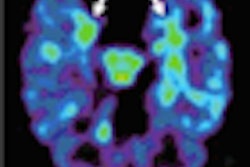PhotoDetection Systems (PDS) believes it has built a more sensitive PET system for humans and is reaching out to some heavy hitters in the medical community to showcase it.
PDS, a privately funded company based in Boxboro, MA, was founded at Boston University's Photonics Center in 1999 and currently employs more than 30 people. Since its inception, PDS has assembled large (90-cm bore diameter) PET systems for OEMs to mount with CT scanners, with the intent of producing the highest PET image quality at the lowest dose, particularly for oncology applications.
But in the South Hall of McCormick Place during the 2008 RSNA meeting in Chicago, PDS shined a spotlight on its newest invention, the NeuroPET scanner, a compact, flexible unit designed for PET scanning of the head.
With an open bore diameter of 30.5 cm, NeuroPET's largest component can fit through a 36-inch door. Each of the three components of the system, including the control console, scanner, and motorized height-adjustable patient bed with detachable headrest, can be moved from room to room on four lockable casters. Collectively, NeuroPET only needs a 10 x 14-ft floor space to perform once it's plugged into a conventional wall outlet.
With PDS' wavelength-shifting fiber technology, NeuroPET patients can be scanned over a series of successive visits due to the low doses of radioactive tracers. But the low dose doesn't detract from imaging sensitivity, according to Bill Mitchell, PDS' vice president of marketing and sales. "NeuroPET is two to three times more sensitive than PET units out there for imaging the brain," he said. As a result, it offers some promising prospects for studying diseases such as Alzheimer's, he noted.
Due to the lower dose delivered with NeuroPET, Mitchell added, the scanner can be used more frequently in repeat scanning of the same subject in a research setting, such as with monthly scans to check the effects of a drug, for example. PDS promotes NeuroPET as an effective tool for monitoring patient response to therapy and new drug trials, as well as for longitudinal studies on how disease progresses.
Reimbursement for neurological PET scans is limited, which is why PET is so oncology-focused. That's part of the reason why PDS is steering NeuroPET toward the clinical research community -- so that it can concentrate on exploring diseases such as Alzheimer's, Parkinson's, Huntington's, and other psychiatric disorders with more frequent, repeat scanning of submillicurie imaging, he said.
NeuroPET is not cleared for marketing by the U.S. Food and Drug Administration (FDA), so PDS is targeting some of the leading academic medical centers with high-profile research departments for placement. As of RSNA, Massachusetts General Hospital was working with NeuroPET, Mitchell said.
By Rick Dana Barlow
AuntMinnie.com contributing writer
January 22, 2009
Related Reading
Analogic acquires minority stake in PhotoDetection Systems, May 23, 2003
Copyright © 2009 AuntMinnie.com




















